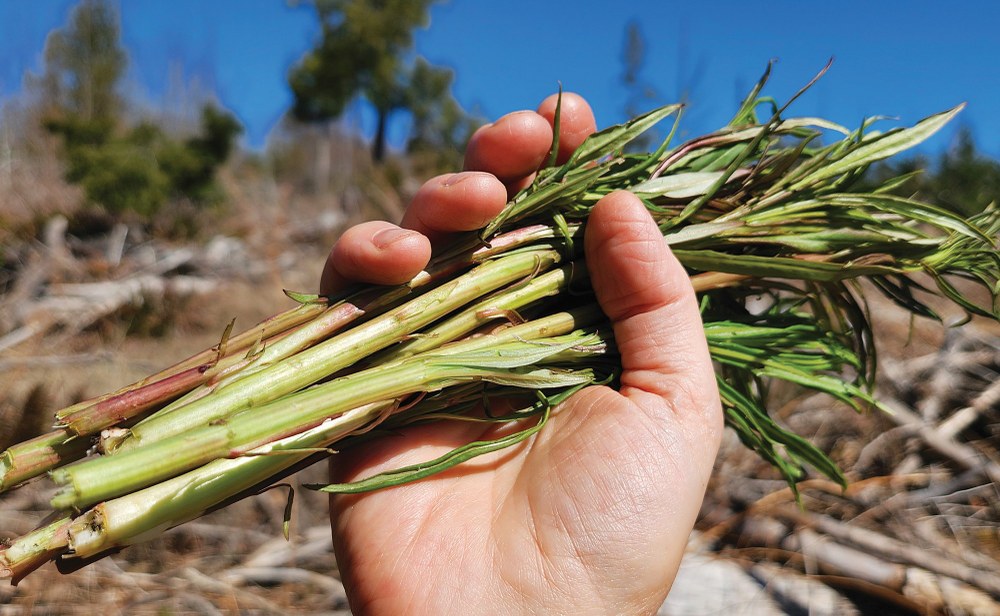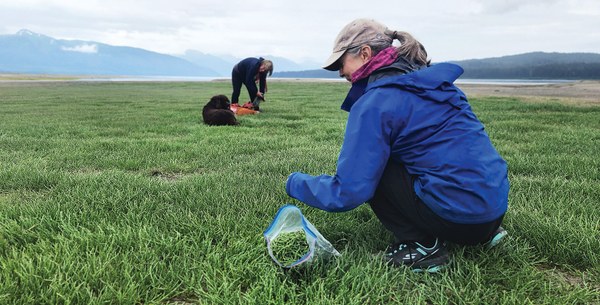
Recognizing local edible berries, flowers, greens, roots, tree parts, mushrooms, seaweeds, beach vegetables, and shellfish is a passport to a comforting sense of place. In Pacific Harvest: A Northwest Coast Foraging Guide, expert forager and longtime guide Jennifer Hahn introduces both novice and experienced foragers to the Pacific Coast’s ample and diverse edible species, while highlighting authentic Indigenous harvesting practices and amplifying profiles of Indigenous leaders in the traditional foods movement. Hahn’s coastal foraging guide offers a sustainable approach to foraging, reminding readers of what other beings also depend on our local plants and animals as food and shelter sources.
Enjoy a sample of what Pacific Harvest has to offer!
Common Fireweed
Chamerion augustifolium
Family: Onagraceae (Evening Primrose)
Status: Native
Other names: Fireweed, willow herb, great willow herb, rosebay willow herb. In Britain, “bombweed” became a moniker for fireweed during World War II for its capacity to sprout in bomb craters (and begin the healing process for war-ravaged lands).
A tall (up to 6 feet), showy wildflower with a torch of fuchsia-pink 4-petaled blooms. Leaves lance- or willow-like, 2 to 6 inches long, and alternate. Blooms from bottom to top, June to September. Bean-like pods pack up to 80,000 airborne seeds per plant that drift like a gentle snowfall. One root sends up multiple plants. Shoots are high in vitamins A and C.
Fireweed is impressively adaptable: circumpolar, found across the northern hemisphere’s temperate regions, including Alaska, Canada, and the Lower 48 — except Texas and the hot, humid south. A pioneer of disturbed sites — clearcuts, burns, river plains, avalanche shoots, where glaciers are retreating, and railroad and road edges — as well as conifer and mixed forests, grasslands, aspen parklands, and muskegs.
Harvest guide
What: Shoots, leaves, flowers
When: Shoots in spring, leaves and flowers in summer
Snap new asparagus-like “shoots” off where the stem is crisp and juicy and breaks effortlessly. If it bends instead of snapping, it’s too old and fibrous. Pick delicate flowers by hand and protect in a hard-sided container. Harvest leaves for tea in the beginning of July or when the plant is in full flower. Research shows this is when fireweed churns out phytochemicals — including ellagitannins (ETs) and oenothein B — associated with fighting cancer, cardiovascular disease, and neurodegenerative disorders. If plants are abundant, slide your fingers down the stalk to take off many leaves at once.
 Harvesting beach asparagus with friends.
Harvesting beach asparagus with friends.
Culinary tips
Cook fireweed shoots like a sort of “wild asparagus.” Saute, roast, or steam; deep-fry as tempura; add to quiche; pickle or marinate. Use fuchsia-colored fireweed petals in salad or as a garnish. Fireweed blossoms can be made into jelly or a mild-tasting syrup. Ferment and dry leaves for Ivan Chai, a flavorful herbal tea.
Superpower
Coast Salish weavers used the silky-haired seeds as soft fiber to weave with mountain-goat wool and dog hair for cozy blankets and as padding mixed with duck feathers in mattresses.
Who eats and shelters here?
Elk, mountain goat, bighorn sheep, pronghorn, and mule deer eat it as a vital spring and summer food. Black-tailed deer munch fireweed during the entire growing season, while moose in Alaska, being picky eaters, prefer the greens before they flower. In fall, pikas and chipmunks nibble pods and cache seeds. Muskrats, rabbits, song-birds, waterfowl, and upland game birds seek its tasty greens and seeds. Beekeepers transport hives to clearcuts for fireweed nectar, which is also a vital fuel for migratory hummingbirds and butterflies.
The large, stout hummingbird moth — nicknamed for its ability to hover and rapidly beat its narrow, birdlike wings as it sips flower nectar — may deposit eggs on fireweed stalks. Also called the white-lined sphinx moth, look for its caterpillar form that wields an impressive but harmless caudal thorn.
Ivan Chai is as easy as pie
Fireweed is circumpolar in the northern hemisphere and is made into tea almost universally in this region. Russian American women in Alaska taught my friend Jensy how they make “Ivan Chai” tea from fireweed leaves. After picking mature leaves, allow them to wilt and roll them vigorously between your palms. With a little practice, it forms a compact pearl with the stem in the very center. Rolling bruises the leaf so it can “ferment” as it dries. Fermenting also creates a more flavorful tea with a slightly floral, green-tea note. In the UK and Ireland — where it is called rosebay willowherb — fireweed is used in tea form to treat asthma.
Dry Ivan Chai tea pearls on a cotton cloth over a wire rack until “bone dry.” Store in a glass jar in a cool, dark cupboard. Ivan Chai keeps its green-tea-like flavor for six months or more.

Pacific Harvest: A Northwest Coast Foraging Guide is available for purchase at our Seattle Program Center Bookstore, online at mountaineersbooks.org, and everywhere books are sold.
This article originally appeared in our spring 2025 issue of Mountaineer magazine. To view the original article in magazine form and read more stories from our publication, visit our magazine archive.
 The Mountaineers
The Mountaineers
